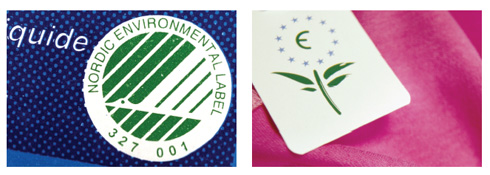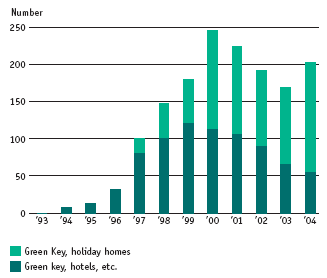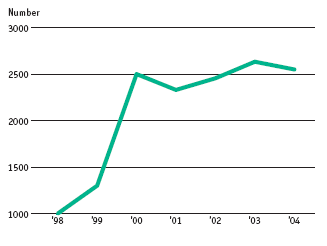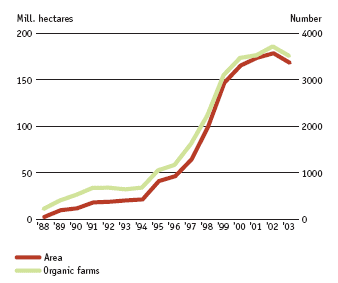Nature & Environment
Making green choices should be easy
As a conclusion to the first part of the campaign "Green responsibility – making a difference", an idea panel gave their recommendations as to what should be included in future work to underpin green responsibility. the idea panel, amongst other things, pointed out that feeling and taking responsibility for the environment should be part of everyone's upbringing, and that it should be easy.
Eco-labelled and environmentally certified goods and services send a clear signal which it is easy for the consumer to relate to. From an environmental perspective, labelled products are from the best part of the market. this means that they have been manufactured in a way that puts less pressure on the environment than other, similar products. moreover, they also lead to less environmental damage when you get rid of them. often, the least environmentally harmful products are also the ones that are the least harmful to the health of you and your family. What is more, you can even save money on, for example, your water or electricity bill.
However, this may be difficult when there are conflicting interests. For example, when economic considerations pull in one direction and environmental or health considerations in another direction. this can be a dilemma when you are considering what to place in your shopping cart, or when you are tempted, against all good advice, to burn waste in your wood-burning stove in order to get cheap heat.

There are more than 3,000 eco-labelled products and services on the Danish market.
The Flower is a european eco-label, whereas the Swan is Nordic. the labels are a guarantee that the products do the least possible harm to the environment. the same requirements to quality and effect apply to eco-labelled products as to other products.
In order to qualify for the Swan or the Flower, a kitchen towel brand must be made from recycled paper or paper originating from wood from sustainable forestry. the paper must be produced in a way consuming the least possible energy and polluting air and water as little as possible. Likewise there is a requirement for limited use of chemicals that can accumulate in the food chain or which have endocrine disrupting effects. Furthermore, the paper towel must have the proper quality.
It is also possible for a hotel to get "an overnight stay" eco-labelled. in other words, eco-labels go across all of the many products and work processes that are part of a hotel. Hotels can get the european Flower, the Nordic eco-label the Swan and the Green Key.
Twenty per cent of the world's largest travel agencies have joined in a uN initiative that makes it possible to choose a travel destination where the local authorities are doing something for the environment. in this way you help ensure that you own stay is less burdensome on the environment.
economic tools
In addition to eco-labels, making it easier to do the right thing for the environment can be achieved by reducing the conflict between environmental considerations and economic considerations, or by making the right choices more attractive. When large public procurement activities promote the market for environmentally friendly goods, prices fall. the
polluter pays principle (PPP), which is part of the eu's new strategy for sustainable development, means that an enterprise, amongst other things, must pay for the environmental impact associated with manufacturing its product. We are familiar with this from taxes on water and energy. When the products that are least friendly to the environment become more expensive, the consumers will choose the more environmentally friendly solutions. a third way is to put a tax on the least environmentally friendly products. For example, plastic carrying bags in supermarkets. this encourages consumers to reuse the bags or bring their own canvas bag and thus help the environment. these tools have an effect irrespective of whether we see the link between our actions and the impact they have on the environment.
environment on the move
The Green Key is an environmental diploma given to hotels, hostels, holiday and conference centres, camping sites, holiday homes, restaurants and sports facilities which fulfil a number of environmental criteria.
In order to achieve the Green Key, the enterprise must comply with a number of specific environmental requirements. the Green Key is a guarantee that the enterprise is working, amongst others, to:
• reduce consumption of water, heat and electricity
• separate and reuse waste
• use environmentally friendly cleaning products
• offer and refer to "green" activities
• incorporate employees and suppliers in environmental-management work.
18 Eco-tourism

Source: The Danish Environmental Protection Agency
This indicator shows the trend in environmental initiatives within tourism in the form of participation in the Green Key eco-labelling scheme. other schemes include Destination 21, emaS, the Flower, iSo 14001 and the Swan.
A few tourist attractions are labelled with iSo 14001 or emaS. the eu label, the Flower, commenced in 2004 with five hotels, and more are on the way. the eco-labels contribute to upgrading and improving the environmental standard of tourist areas and facilities. the generally declining participation in eco-labelling schemes since 2000 is reversing with new labels such as the Flower and an increasing number of eco-labelled holiday homes.
19 Eco-labelled products on the danish market

Source: Eco-labelling Denmark
This indicator illustrates developments in the number of eco-label licenses and the number of eco-labelled products on the Danish market. the figures describe Swan and Flower-labelled products. one license can apply to many trade names, sold to different retailers.
During the period 1998 to 2004, the number of widely available eco-labelled products rose steadily. the most commonly seen eco-label is the Swan label,
but the Flower is making good progress. in 1999, two products bore the Flower, and in 2000 the corresponding number was seven. However, in 2004 the Flower label accounted for almost 10 per cent of eco-labelled products on the market. the increase in the number of products bearing the Flower really picked up with the eco-labelling campaign initiated in 2001; and with the Flower campaign in a large part of the eu during october 2004 the number of products on the market reached 210.
The decrease in the number of product licenses from 2000 to 2001 is due to a drop in the number of Swan licenses for paper for printing, as the major manufacturers no longer thought
The number of eco-label licenses for paper for printing is, at present, 124, and the number is expected to grow.
Every three to five years, eco-label licenses for a given product area must be renewed due to a tightening of regulations. most often this gives rise to a drop within the area in question. apart from the reduction in Swan label licenses on paper for printing in 2001, trends are positive for the other product groups. this goes to show that tightened regulations are working as intended. the aim is that as many products as possible
of the top third or quarter of products on the market are eco-labelled, so that the market can support a sustainable development.
20 Organically farmed food

Source: The Ministry of Food, Agriculture and Fisheries
The Danish Ø-label indicates that the product is guaranteed by state-control to be organically farmed. the label can apply to agricultural commodities farmed according to the eu's regulations for organic farming, including a number of special Danish provisions, or according to Danish regulations for organic livestock farming. Foreign organic food can obtain the label, if it is packaged and inspected in Denmark.
Organic means that no pesticides have been used in the production, except for a few exceptions (e.g. sulphur). artificial fertilisers are prohibited, and
as a general rule fertiliser from non-organically produced livestock must not be used. organic livestock are not given growth enhancers and at least 80 per cent of their feed is organic (90 per cent for cattle, sheep and goats). Bone meal and genetically modified organisms (Gmos) are also not allowed. Ø-labelling is a voluntary scheme. the Danish ministry of Food, agriculture and Fisheries ensures that regulations are complied with.
The graph shows that the overall area of organically farmed farmland has increased significantly since the mid-1990s. in 2003, organic farmland made up 165,622 ha. this development, however, has stagnated in the past couple of years.
In 2003 there were a total of 3270 organic farms in Denmark, corresponding to 6.7 per cent of all Danish farms, and 6.2 per cent of the total area of farmland. in relative terms, organic farming in Denmark is among the largest in europe.

Version 1.0 July 2007, © Danish Environmental Protection Agency